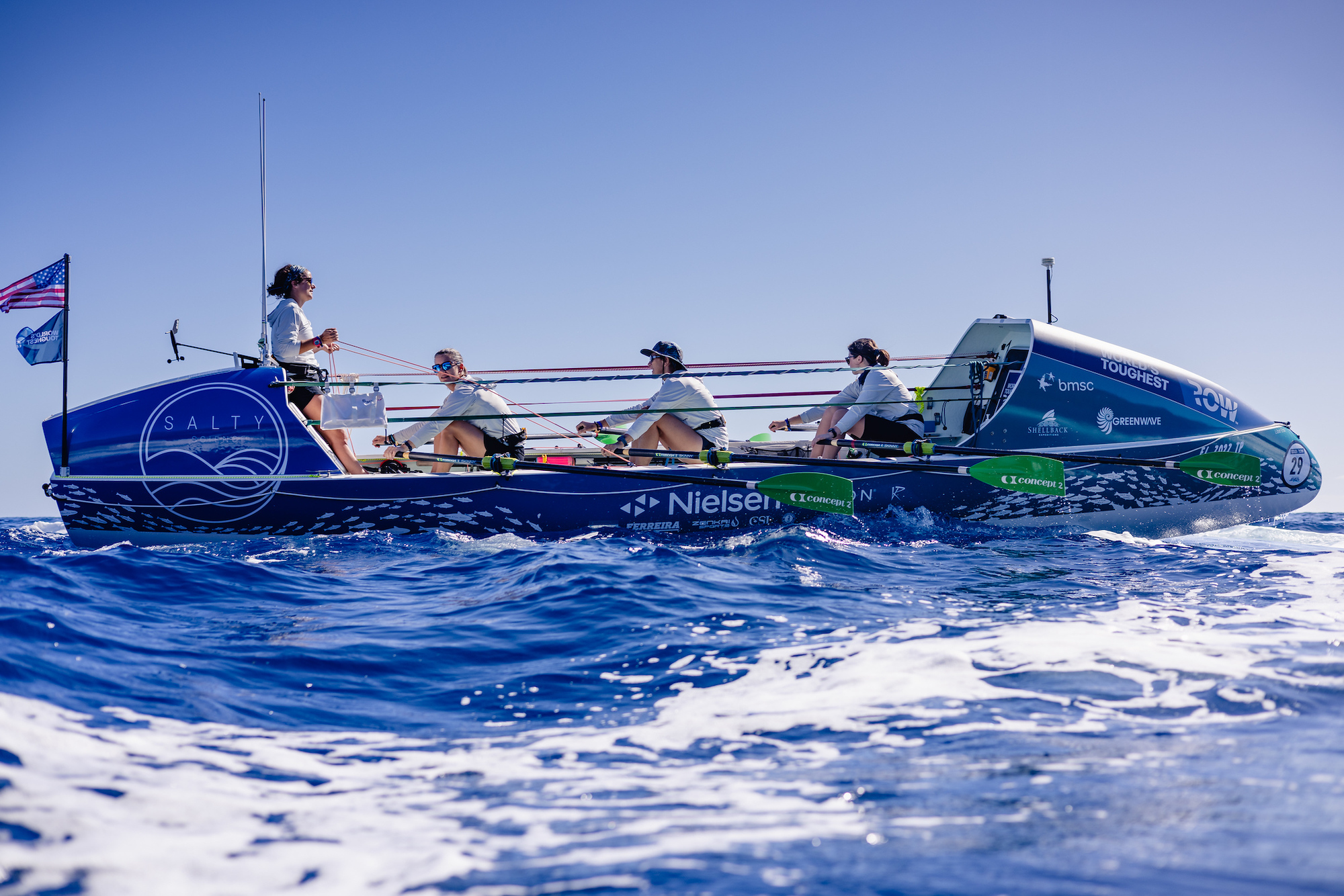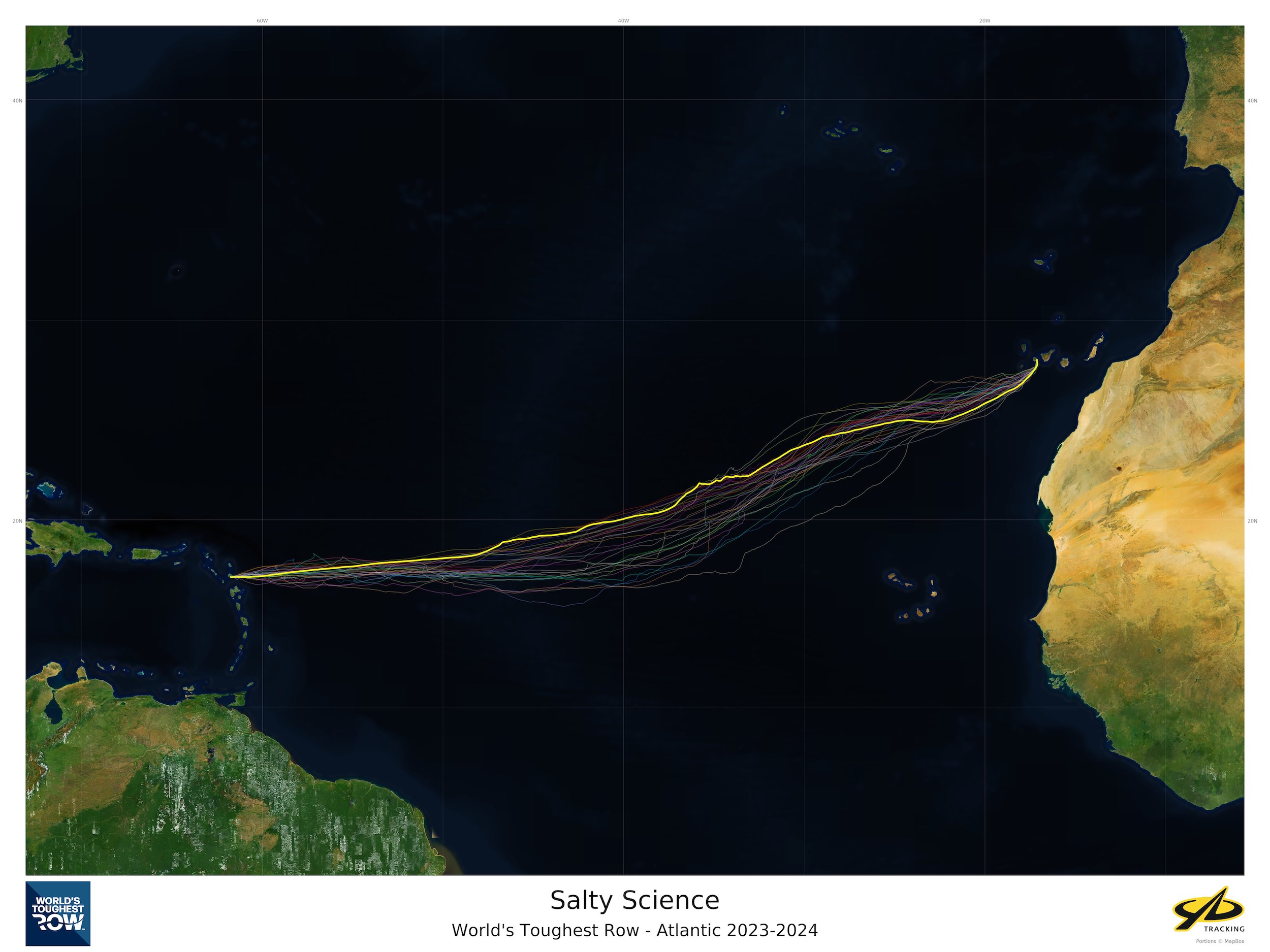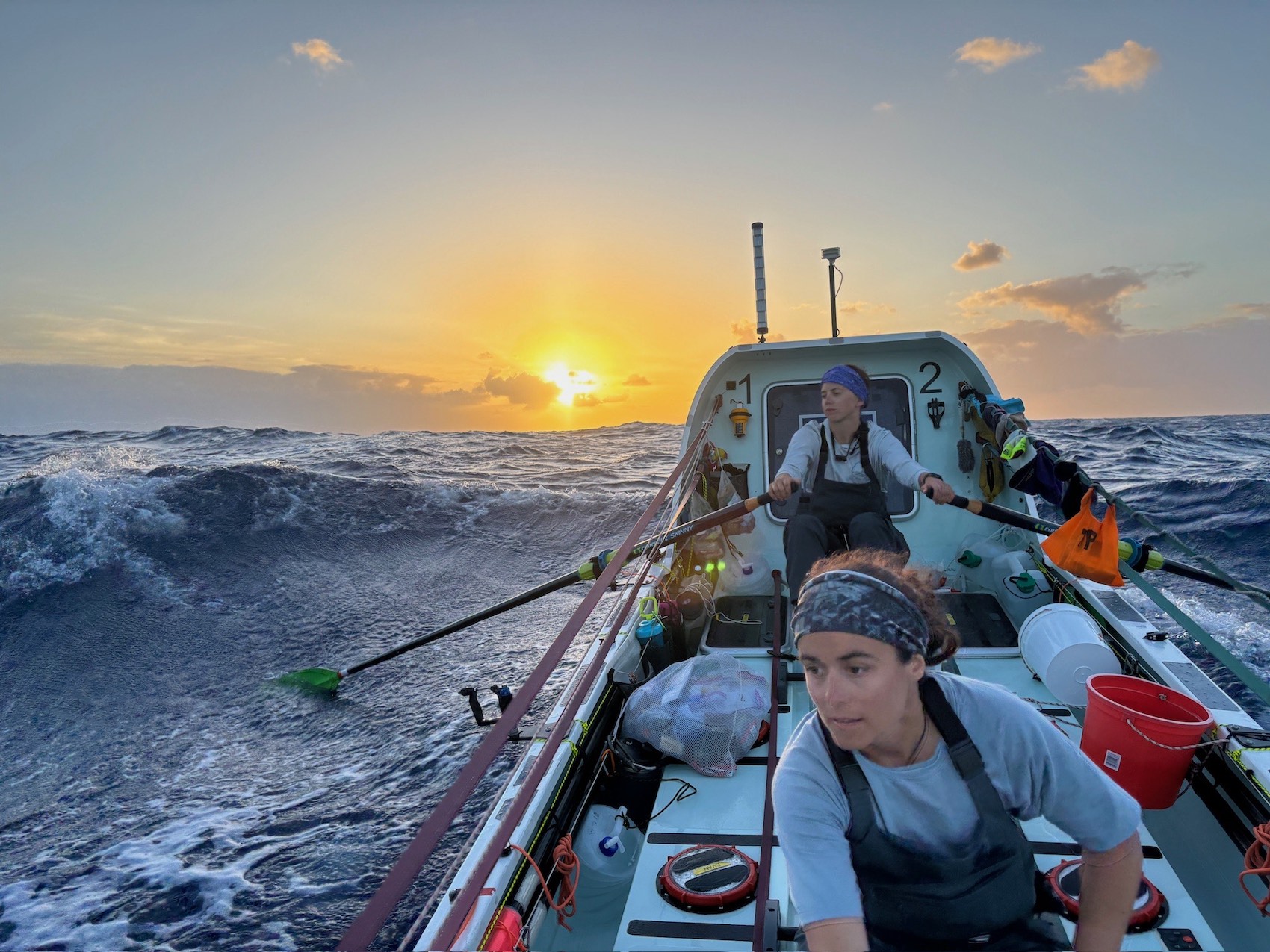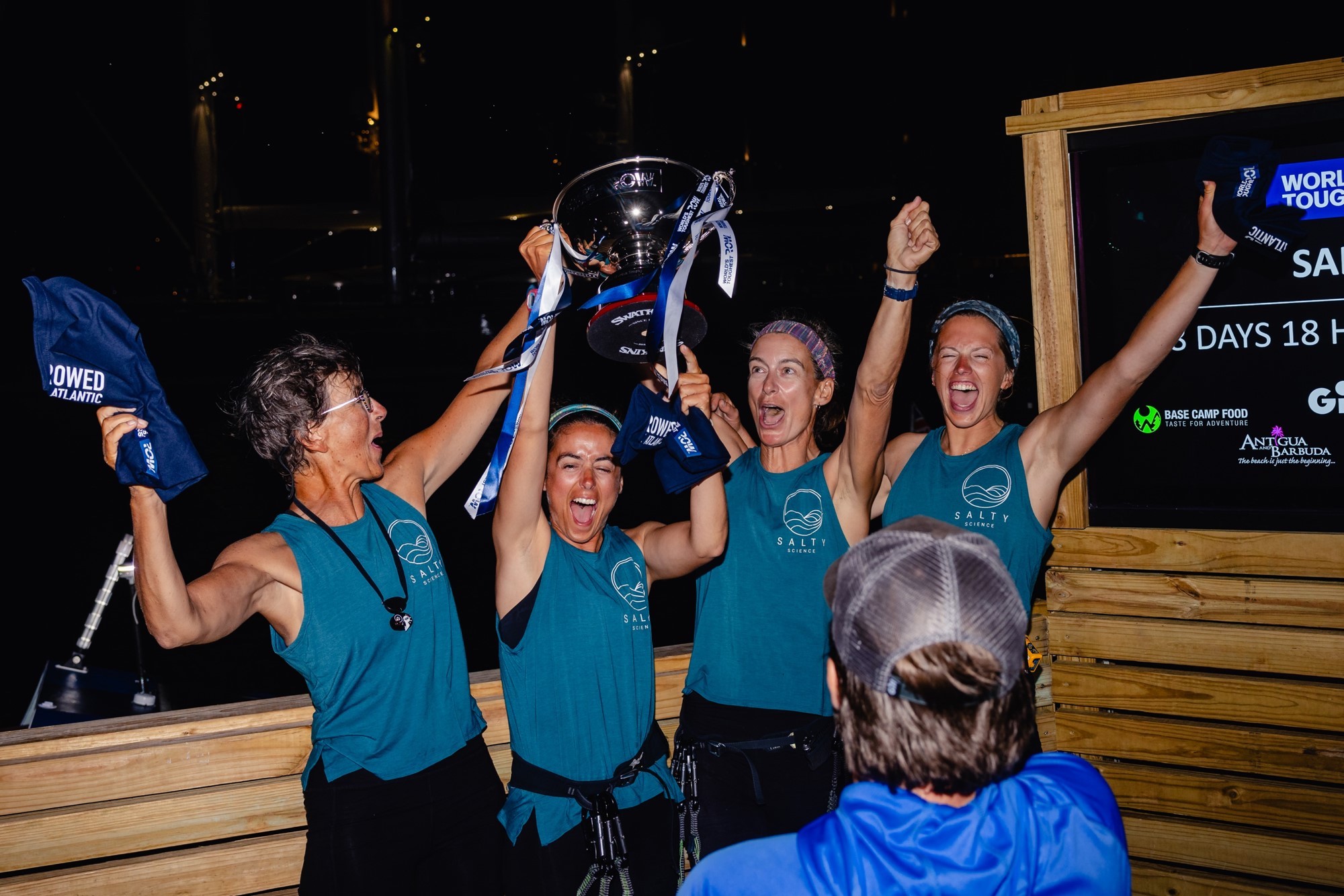Marine scientist rows across the Atlantic
Ned Rozell
907-474-7468
March 14, 2024

From left, Lauren Shea, Chantale Bégin, Isabelle Côté and Noelle Helder propel their 28-foot boat Emma off the coast of Florida during a training run for their crossing of the Atlantic Ocean.
The first days were the hardest days, Noelle Helder said.
Imagine being as seasick as you will ever be while surfing waves that look like mountains. You can’t sleep during nights that make you wonder when your boat will crumple like an aluminum can. The nearest help is on a continent you can’t see, and beneath your running shoes are 3 miles of deep blue sea.
Helder, a marine scientist currently working on several projects at the University of Alaska Fairbanks, recently was one-fourth of an all-woman team they named Salty Science that won the women’s division of the World’s Toughest Row, from the Canary Islands offshore of northwest Africa to Antigua, just north of South America.
With each woman clipped into the open boat with a tether they had worn for more than a month, team members rowed into Antigua on Jan. 20, 2024.
That’s more than 3,000 miles of ocean crossed in 38 days by four women from the far corners of North America.
Helder lives in Fairbanks, where she squeezed a borrowed rowing machine into her cabin and pulled many strokes to the bewilderment of her dog. Her partners in the event were Chantale Bégin from Tampa and Isabelle Côté and Lauren Shea from British Columbia. All four are marine biologists who had worked on projects together.

The yellow line reflects the GPS tracking of the Salty Science four-woman team’s crossing of the Atlantic Ocean from off the coast of Africa to north of South America.
“We had a funky academic thing going on,” Helder said during a recent presentation about her trip at the University of Alaska Fairbanks. She is currently working with scientists at UAF’s Institute of Northern Engineering on a coast of Alaska mapping project.
None of the four members of the Salty Science team had any rowing experience, Helder said. But they had enthusiasm.
Helder, who just turned 29, said “yes” immediately when Shea, in Antigua for field work a few years ago, texted her about attempting the World’s Toughest Row. Shea had just watched the race finish in person.
Accepting the challenge was one thing. Making it happen was something that took up the last three years of Helder’s life. This included her relocating to Florida for the summer of 2023 to learn how to row in the open ocean with her teammates.
There, they became acquainted with Emma, a 28-foot rowing craft shaped like a beer can. Emma featured an open deck with three sliding seats and sets of oars, two tiny cabins where one person could sleep amid their electronics, a machine that could make salt water drinkable, a touchy mechanical rudder that steered them and a bucket they used as a toilet.
Before the trip, the women employed a rowing coach as well as a psychological one. The latter suggested their mantra: “Feel the fear, and do it anyway.”
They each learned how to fix the electronics on board and how to dive beneath the boat while on a line to chip barnacles off Emma’s hull with a paint scraper. They packaged up two months’ worth of dehydrated food and learned how to wedge it into every precious inch of space.
They departed the bay in La Gomera, Canary Islands (a territory of Spain), on Dec. 14, 2023. Sand from a Sahara dust storm fuzzed up the green horizon as they pulled away.
It was their last sight of land for more than a month. They didn’t see another oceangoing boat for more than a week. But they were too sick to care.

Lauren Shea, foreground, and Noelle Helder row into the sunset as they cross the Atlantic Ocean as part of a four-woman team.
“There were 4-to-5-foot swells right away,” Helder said. “We would throw the oars, puke and keep (rowing).”
The women knew this rude introduction to ocean rowing was coming. Things got worse before they got better.
“We were shocking our systems,” Helder said. “We knew — hoped — it would end. I don’t think I ever need to be in a 28-foot boat in 30-foot seas again.”
In addition to the sea sickness, there was the damage the ocean was inflicting upon their boat. One series of waves bent an oarlock plate made of quarter-inch steel, rendering one of their rowing stations useless.
“Days felt fine, but the anxiety level went up in the middle of the night,” Helder said of the first few days. “Once or twice a night we had to wake everyone up to help row or stabilize a chaotic situation after a big hit, or because water would pour into the cabin from a big wave that washed over the deck through the vents — which is not a fun way to be woken up.”
But Emma’s fiberglass body absorbed the punishment, and all four women recovered from seasickness.
After four days, they all got into a working rhythm during which they alternated rowing partners. Each had a shift of two hours of rowing followed by two hours of rest alone in the tiny cabin. After the sun set, they pulled for three hours and rested for three.
“Sleeping three hours was a game-changer,” said Helder, who was amazed at how their bodies and brains were able to adapt to nonstop motion, and to almost never standing up straight during 38 days of routine tasks.
“There was never a moment it was dull,” she said. “We’d see a bird and talk about it for a day.”
A flying fish that bounced off Helder’s head while she was rowing also broke up the monotony, as did groups of sleek tuna that followed Emma. A shark also butted its head repeatedly against the rudder (without damaging it).
During the journey, the four women celebrated Christmas, New Year’s Eve and Shea’s birthday (presenting her with a cheesecake). Sunrise coffees were a favorite part of each day, as were listening to audiobooks and music and preparing meals with a JetBoil stove. Each woman ate about 4,200 calories each day.
Despite being rowing novices at the start of the trip, when they were more than halfway across the Atlantic they learned via their satellite texters that they were ahead of every other women’s team. They maintained their lead by analyzing weather reports and anticipating wind patterns. This allowed them to chart the best path to Antigua in the final days.
“We won because we made smart navigational decisions,” Helder said.

From left, Isabelle Côté, Lauren Shea, Chantale Bégin and Noelle Helder celebrate crossing the Atlantic Ocean in 38 days in Antigua on Jan. 20, 2024.
Arriving at the port of Nelson’s Dockyard, Antigua, in the darkness of Jan. 20, 2024, the women squinted at spotlights pointed at them by race officials and struggled to stand up on deck and hold torches handed to them for celebratory photos.
The four then stepped off Emma and onto dry land for the first time in 2024. There, they hugged friends and family.
Not only did the women win the forever right to say they rowed the fastest across the Atlantic Ocean, they raised more than $260,000 for three ocean-conservation organizations.
“I’m very happy I did it,” Helder said in Fairbanks. “And I’m so proud of our team.”
Helder said the next time she crosses an ocean she will employ a sail rather than oars. She also said she hopes her experience of riding the waves sticks with her.
“It made me feel an incredible sense of connection with the natural world that I hope to continue to hold on to in my everyday life,” she said. “Seeing nothing but ocean for 38 days . . . reminds me how small we are in the grand scheme of things. It only furthered my excitement for spending time in, on and around the ocean whenever I get the chance, and to continue to work to understand this incredible ecosystem.”
Since the late 1970s, the University of Alaska Fairbanks' Geophysical Institute has provided this column free in cooperation with the UAF research community. Ned Rozell is a science writer for the Geophysical Institute.


